Like lots of folks, we’ve got a list - some people will call it a bucket list. Ours is more like a steamer trunk of interesting, if sometimes ill-conceived, ideas for misadventures one might argue are just as likely to result in an untimely death as contribute to a fuller life. They’re the sorts of ideas often born from past travels, which include everything from learning to ice climb in the Rockies and sail in California to most recently learning to kiteboard in Brazil. Ideas we find inspiring, although I’ve been told we’d be better off viewing it as a list of things to avoid should we hope to preserve our 40-something bodies into our 50’s.
Some years back, kiteboarding made this list thanks to Pat and Ness, two globetrotting English doctor friends, who’ve spent half their adult lives exploring the world on their trusty BMW motorcycle and the other seeking out new wind-fueled adrenalin sports. Pat and Ness discovered kiteboarding while windsurfing one summer in Tarifa, Spain. Ever since, it’s become something of a religion, which they practice for months on end. Each year they follow the winds from Spain to South Africa and back again, finding just enough time in between to do a bit of doctoring and a lot of lobbying for us to give the sport a try.
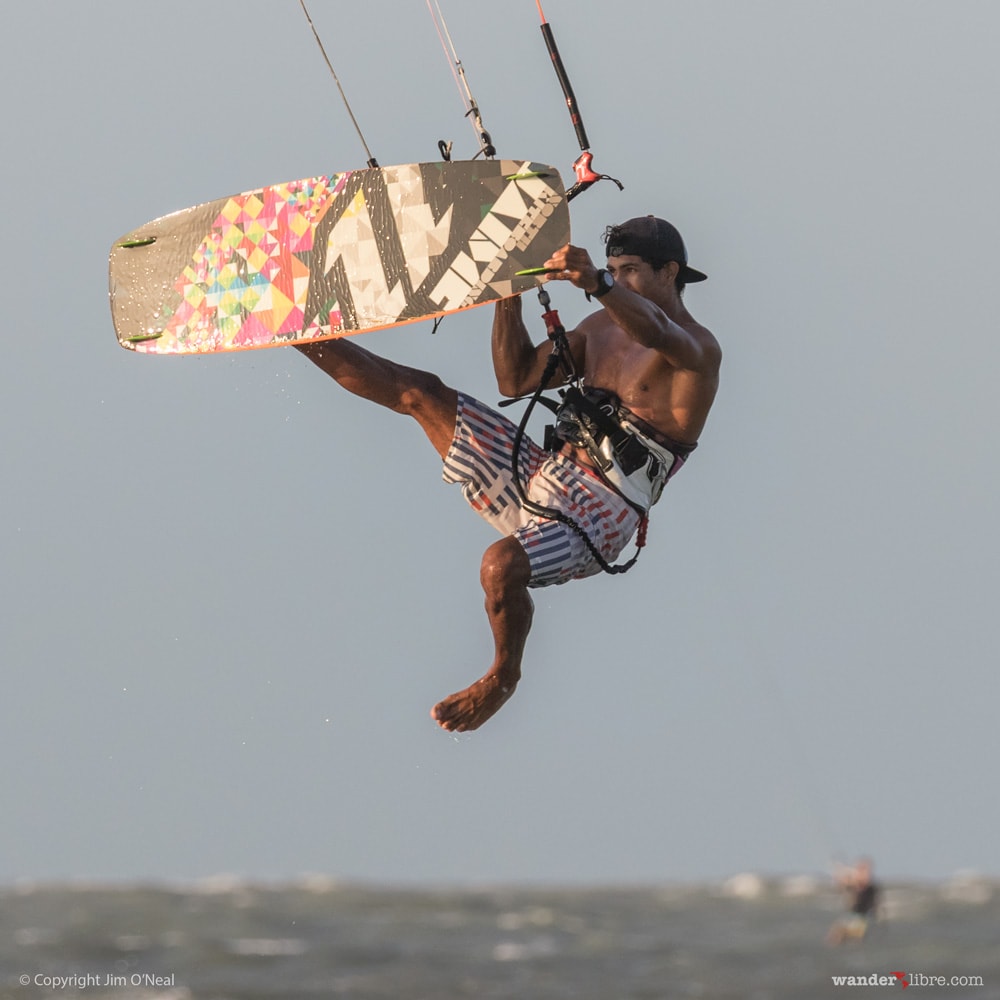
For those who aren’t familiar, kiteboarding’s where you ride a board using a kite to power you across the water. If you’ve tried surfing, snowboarding, wind surfing, wakeboarding, or sailing it’s a little like all those sports and yet not exactly like any of them. It’s a sport that’s both adrenalin-packed and totally mellow. It just depends on what you want to get out of it. For some it’s about going fast and catching big air, while for others it’s more about the endless ride. An opportunity to cruise across a glassy turquoise lagoon set against a picture-perfect tropical sunset.
In many ways it’s pretty much our ideal sport. Adrenaline - check. Beach, sun, and sand - check. Playing in the water - check. Riding the winds - check. High perceived probability of breaking our necks - check. But despite this, it’s one of those sports that took a long time to make the top of our list - tossed into an abyss labeled ‘got to be in the right place at the right time.’
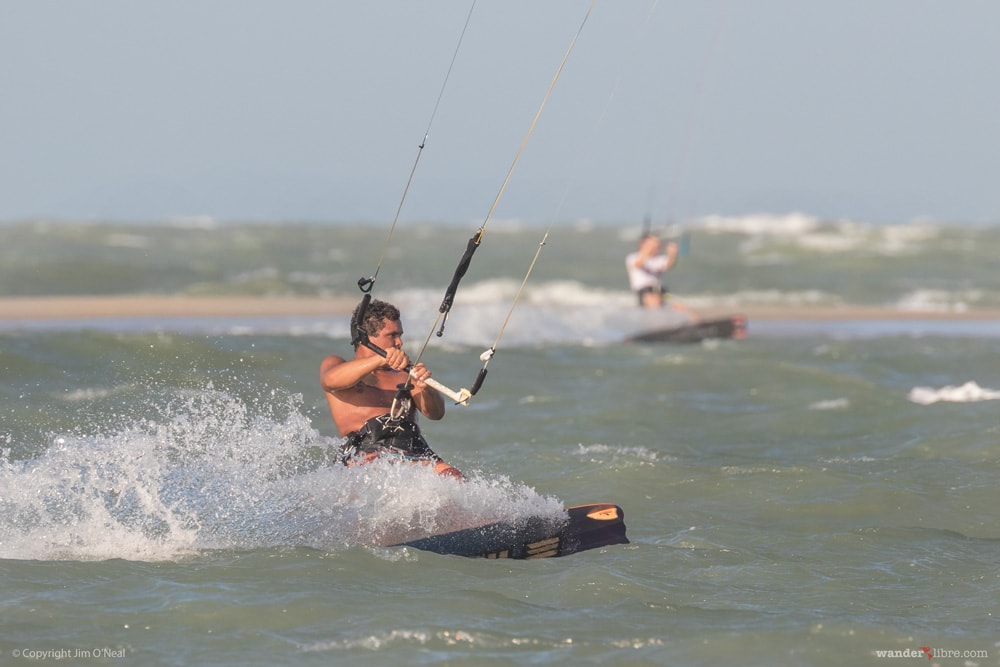
We finally found that right place and time in Praia de Macapa, Brazil. It’s not a place we sought out for kiteboarding. Rather, we arrived in Praia de Macapa road weary and hoping to find a quiet stretch of beach to lick our wounds after three hot and buggy months in the Amazon and Guianas. However, it didn’t take long to realize we’d stumbled into a perfect spot to give kiteboarding a try.
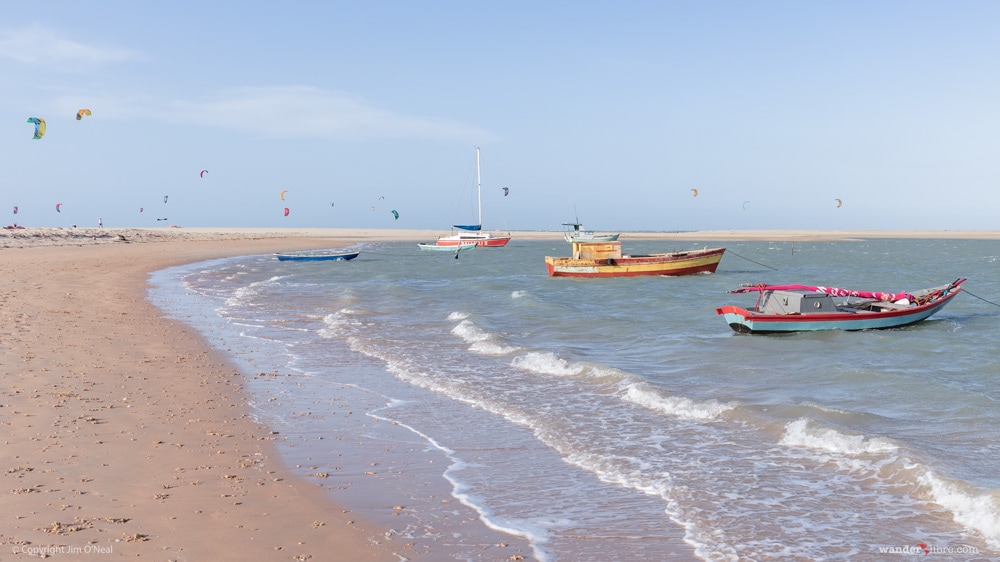
After a long drive, we arrived in Praia de Macapa late one afternoon primed for sundowners. Situated at the mouth of a beautiful estuary, Praia de Macapa’s a tiny fishing village nestled amongst a sea of ever-shifting dunes bleeding into a shallow turquoise lagoon. Think white sand spilling across quaint streets where wild donkeys amble along without a care in the world. It’s a place that exudes a lazy beach vibe. The type of vibe that had us out of the car and under a beachside cabana before our Land Cruiser came to a complete stop.
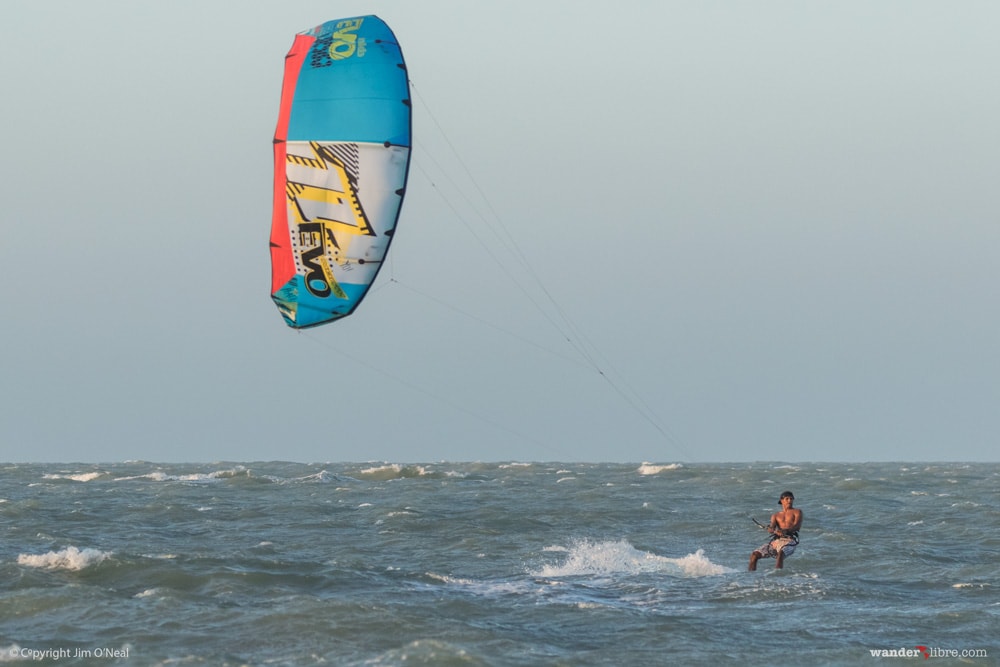
Relaxing on a picturesque white sand beach, cold beer in hand, we watched a mix of local and European kiteboarders put on a show that had us longing to get out on the water. It was a relaxed end to a day that began camped at a Brazilian truck stop, where we awoke to find three drunks peeing on the side of our Land Cruiser. But that’s a story for another day.
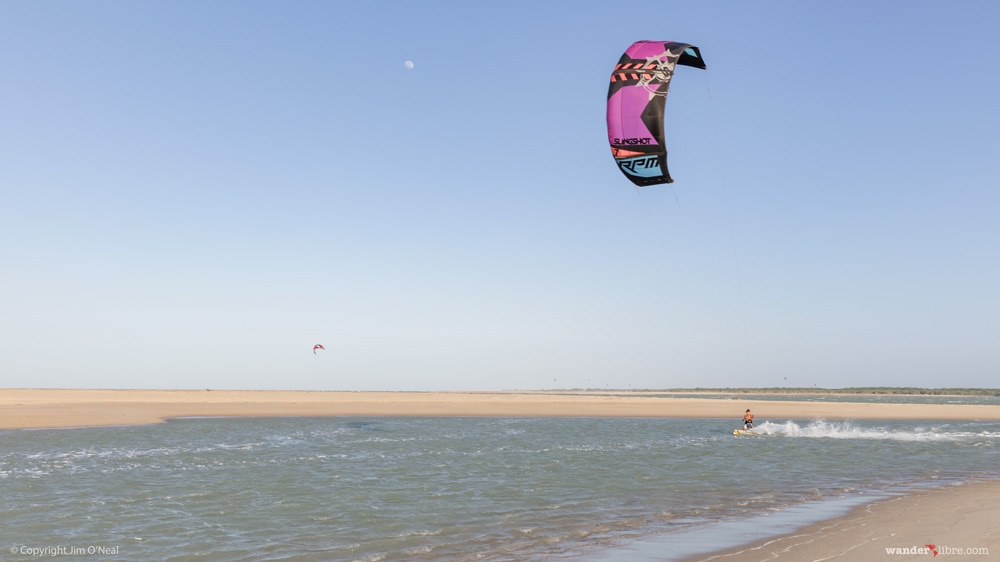
What Sheri and I were yet to realize was that we’d inadvertently stumbled onto a beach that’s quickly becoming known as one of the best kitesurfing spots on earth. Accordingly to the owner of our guesthouse, each year the number of kiteboarders coming to Praia de Macapa doubles. It’s a trend that started about six years ago as word began to spread about the perfect mix of strong, reliable winds, warm turquoise water, shallow lagoons, white sand beaches, and sleepy village vibe.
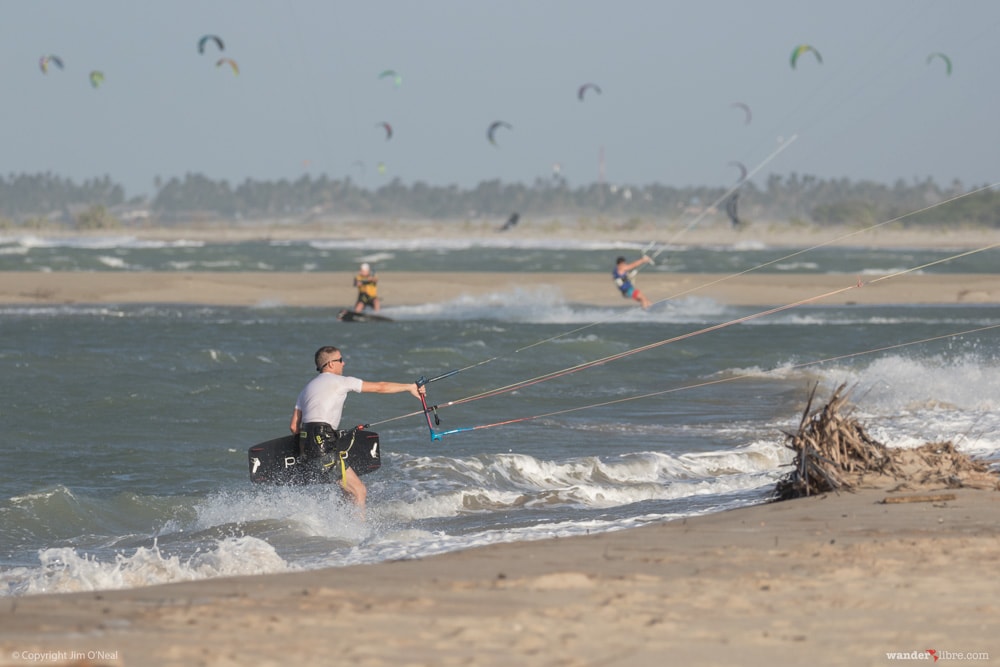
The next morning we met with Lisa at Beekite Brazil about possibly taking lessons. Lisa was a great ambassador for the sport. A friendly German who speaks good English, Lisa owns Beekite with her Italian husband, Michele. Together they bounce between Italy, Brazil, and Germany where they run three kiteboarding centers, which cater largely to a European clientele.
At Beekite, Lisa provided a thorough overview and helped us make a plan. As newbie’s, we were looking for a school that made us comfortable. This is where Lisa shined, patiently answering our questions - not missing a beat when I (half) jokingly asked if they offer a search and rescue service should one of us get blown out to sea.
Thanks to Lisa, by lunch all our fears were allayed and all our ‘buts’ rebutted. We had a plan, which would hopefully take us from zero to kiteboarding. And if not, we felt confident Lisa’s team would be there to pluck us out of a tree.
Over the next three weeks, we worked with Marcus, our private instructor. A German from Munich, Marcus spoke perfect English in an accent I can only imagine was refined through an unhealthy addiction to American pop culture. Patient and knowledgeable, Marcus methodically coached us through the steps. In between our sessions with Marcus, we either indulged in heaping bowls of acai while kicking back in a hammock, or sipping on Brazil's famous cocktail - the caipirinha.
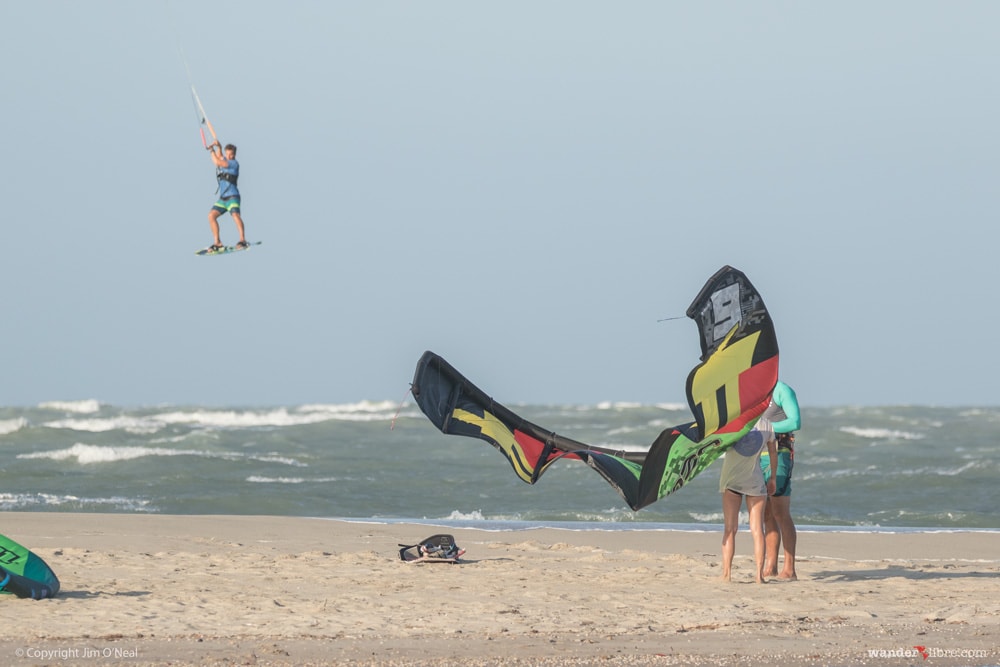 Learning to kitesurf is a pretty straightforward process that involves working through a series of progressives steps designed to safely go from zero to riding. The first step was our introduction to the sport. It’s the part where we learned the theory of it all and got fitted with equipment. It’s also where Marcus gave the ever-important safety briefing. You know - the one that makes clear getting dragged across a beach by a giant kite in 30-knot winds is something best avoided.
Learning to kitesurf is a pretty straightforward process that involves working through a series of progressives steps designed to safely go from zero to riding. The first step was our introduction to the sport. It’s the part where we learned the theory of it all and got fitted with equipment. It’s also where Marcus gave the ever-important safety briefing. You know - the one that makes clear getting dragged across a beach by a giant kite in 30-knot winds is something best avoided.
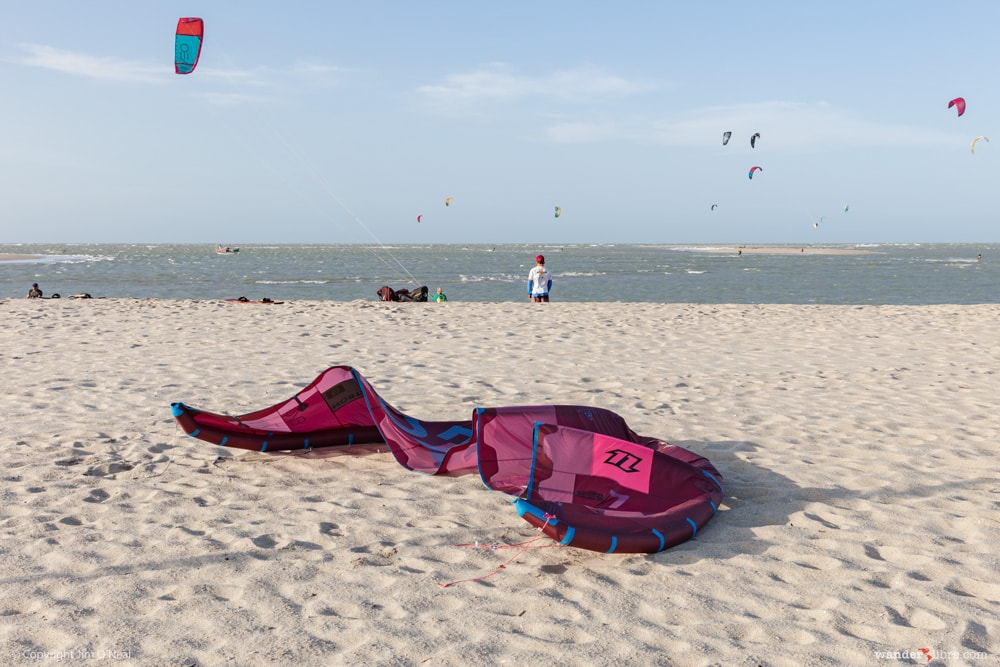
From theory we progressed to step two - setting up, launching, and flying our kites - using a soft (trainer) kite on the beach. It’s not unlike flying a kite as a kid, only with a kite that’s capable of lifting you off the ground. Do it right, and it’s like walking a well trained Great Dane on a leash. Get it wrong, and it’s more like attaching the leash to a horse that just got a hot poker up its ass. Practicing in 25-knot winds added a bit of spice to our first training flight. In the first three hours, we got tossed about the beach, not completely in or out of control. It was our first opportunity to fly and first chance to feel the kite’s power. It’s a sensation that’s immediately addictive, and within no time we were pulling off figure eights, power dives, and other maneuvers.
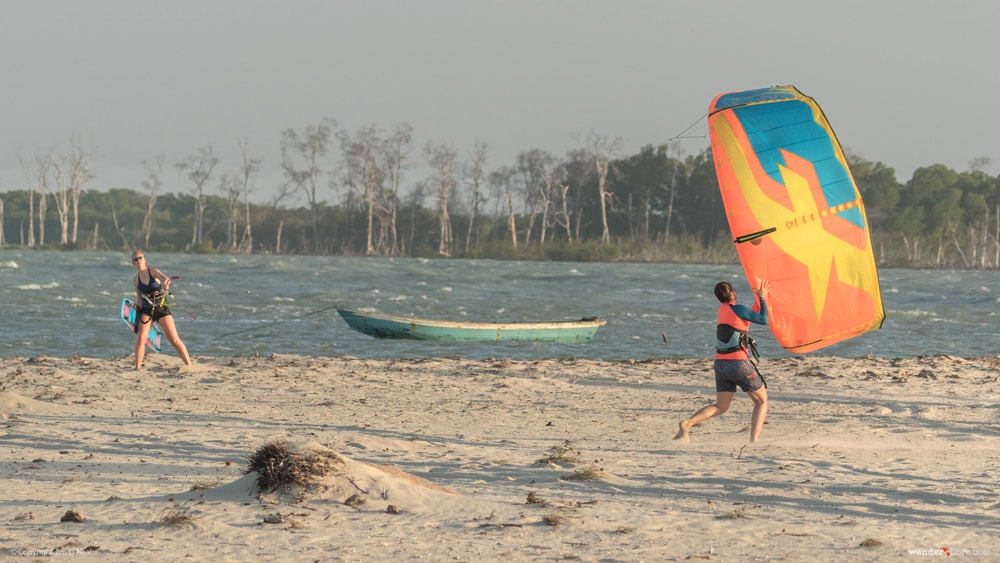
Once Marcus was convinced we could fly without killing ourselves, destroying the kite, or crashing into a passersby, we advanced to step three – flying a proper kite (called a tube kite) in the water. I loved this phase. Tube kites are fast, responsive, and fun to fly. Starting with a 6 square meter kite in 20-30 knot winds, the force the kite generated was impressive. Power dive too deep and you’re flying through the air. I'd start the power dive in one spot, and a moment later, I’d be bound for another - out of the water and hurling forward before touching down with a splash. The immediacy of it is unlike anything else. It’s like going 0-60 mph in a car instantly.
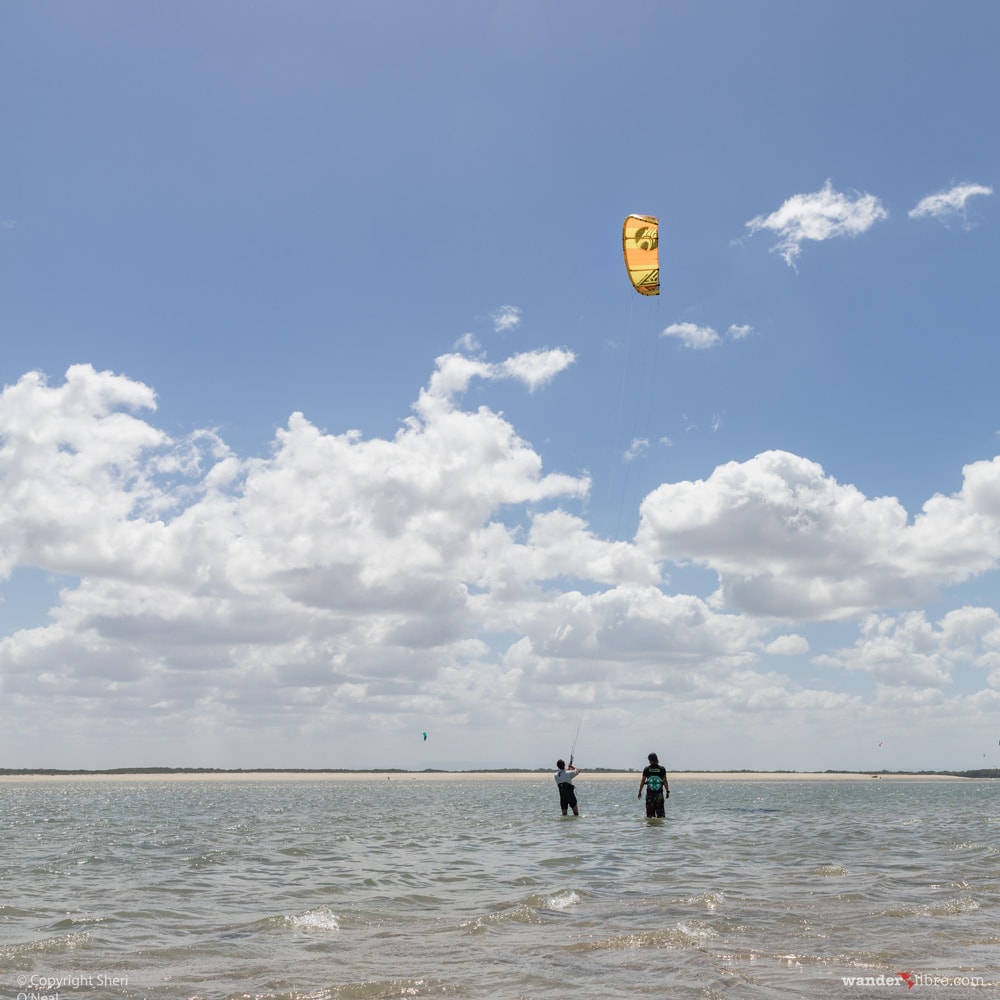
Having mastered basic flying skills, we moved on to step four – the body drag. Body dragging is pretty much what the name suggests. It’s kiteboarding without the board. It’s not pretty and won’t land you a Red Bull sponsorship but it’s an important skill to master. When Marcus demonstrated, I couldn’t help but think that doing it right looks strikingly similar to getting dragged out of control. Picture an old western where some guy gets lassoed and drug behind a horse. Being in control is the difference. Body dragging is that key skill that allows you to travel through the water without a board. Not unlike sailing, learning to body drag allows us to tack/jibe our way upwind or down between two points. It’s an exceedingly effective way to recover a lost board (something I’ve had plenty of time to practice since first standing up).
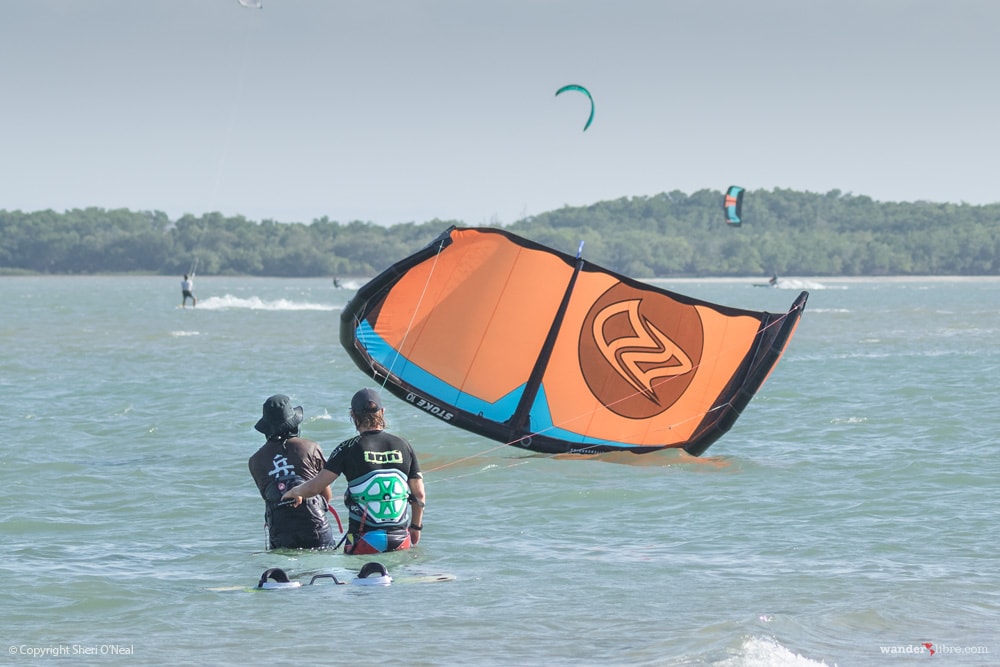
I’m convinced body dragging is a right of passage, and once Sheri and I ingested enough seawater to convince Marcus we’d paid our dues, we got the nod to move on to step five – learning to ride. Our first day learning to ride was frustrating and painful. I say frustrating because Marcus’ demonstration made it look so easy. Floating in the water he simply put the kite to 12 o’clock, positioned his body correctly, did a quick power dive, and he was up and gone. My timing, however, was clearly a bit off and while I found it easy to get up, I found it hard to get going. Again and again, I’d get up only to either sink back down or get launched forward through the air. Getting launched – superman style – was painful. Repeatedly, I’d whip forward through the air, landing with a bone-jarring crash that had me convinced I’d broken some, if not all of, my important bits. Sheri meanwhile suffered the same timing problem but without the superman theatrics as she quickly mastered the “let go of the bar” method of depowering the kite. A skill Marcus assured me is almost always mastered by levelheaded girls faster than bullheaded guys.
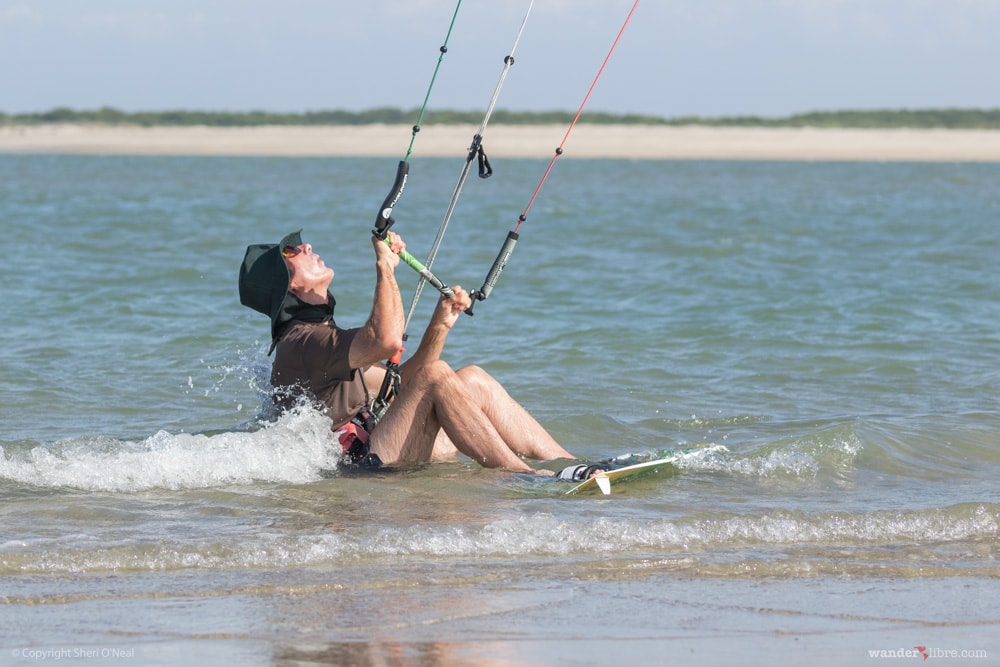
On a side note, as a newbie, getting launched makes it easy to lose sight of the kite, which inevitably led to some pretty dramatic kite crashes. An event that adds insult to injury as the kite makes quite a noise when it smacks the water, which draws worried looks from anyone in earshot. A point driven home that night when two Austrians staying at our guesthouse gave us a pat on the back and said “We saw you out there today. Looks like you had a rough afternoon. Don’t worry guys. We’ve all been there. We promise. It gets better. Just stick with it. At least you didn’t break anything.” We received similar pep talks from everyone we met. French, Germans, Italians, Brazilians, and Austrians. All were incredibly supportive, which felt good, although the number of people who said “I saw you out there today….” was both encouraging and embarrassing, as I’m sure we put on quite the show.
The great thing about kiteboarding though is that progress is steady and working through a problem is often as easy as taking some time off the water to think through the steps. That’s what we did before heading back out, and the second time we were both up and riding immediately.
My first ride was nothing like I expected. Rather than feeling like the kite was dragging me through the water like, say, water skiing, I felt like I was effortlessly gliding across the water’s surface. Traveling much faster than I anticipated, I felt an immediate adrenalin rush that was addictive and offered insight into what the sport has to offer.
For the balance of our stay, we worked to improve our skills. To become more proficient at water starts, tack upwind, self-rescue, and acquire the myriad other skills necessary to get good at the sport. We found learning, with all the ups and downs, to be incredibly fun. Every step in the learning process from flying a kite on the beach to riding across Praia de Macapa’s shallow turquoise lagoons was a blast that left us longing for more.
So where do we go with kiteboarding from here? For us it’s more about the endless ride and cruising across a turquoise lagoon than chasing an adrenalin rush and catching big air. We see kiteboarding as another unique way to explore the world. It’s a perfect sport to add to an extended sailing trip and a sport that offers added incentive to explore places like Madagascar, Sri Lanka, Egypt, and South Africa – all great kiteboarding destinations.
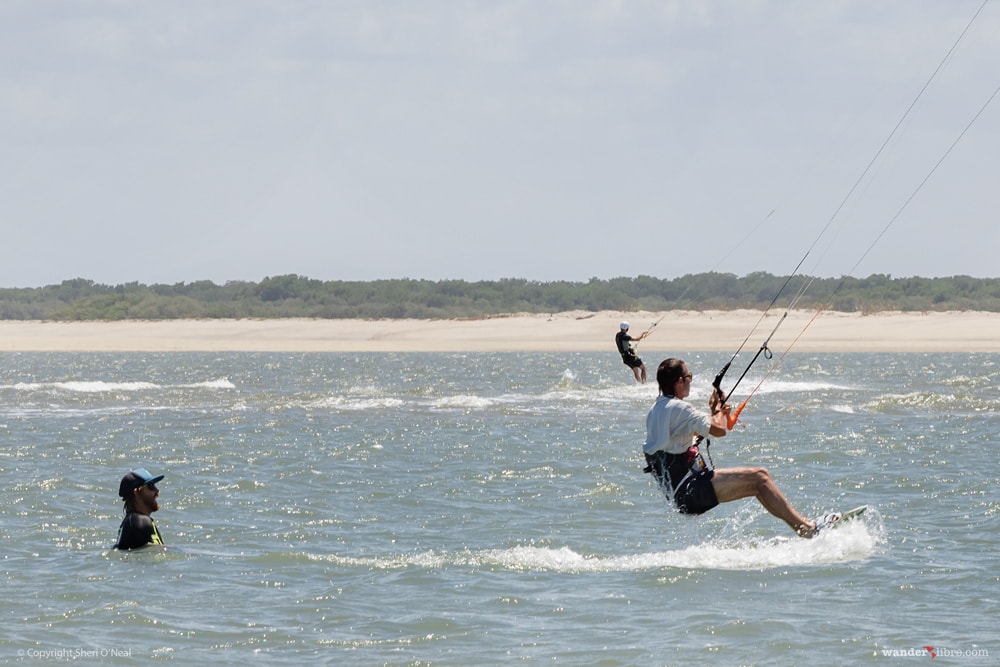
If you’re looking for a new water sport that’s a great match with travel, offers boundless possibilities, and an adrenalin rush unlike anything else, I’d recommend giving kiteboarding a try. And if Brazil’s on your travel list, there are few places better than Praia de Macapa to learn to ride.
It's Brazil at its most relaxed. Small, quaint, and blissfully void of distractions. Praia de Macapa is a great place to spend some time on the water followed by some time in the hammock (caipirinha in one hand and a good book in the other). Not a bad way to spend a holiday!
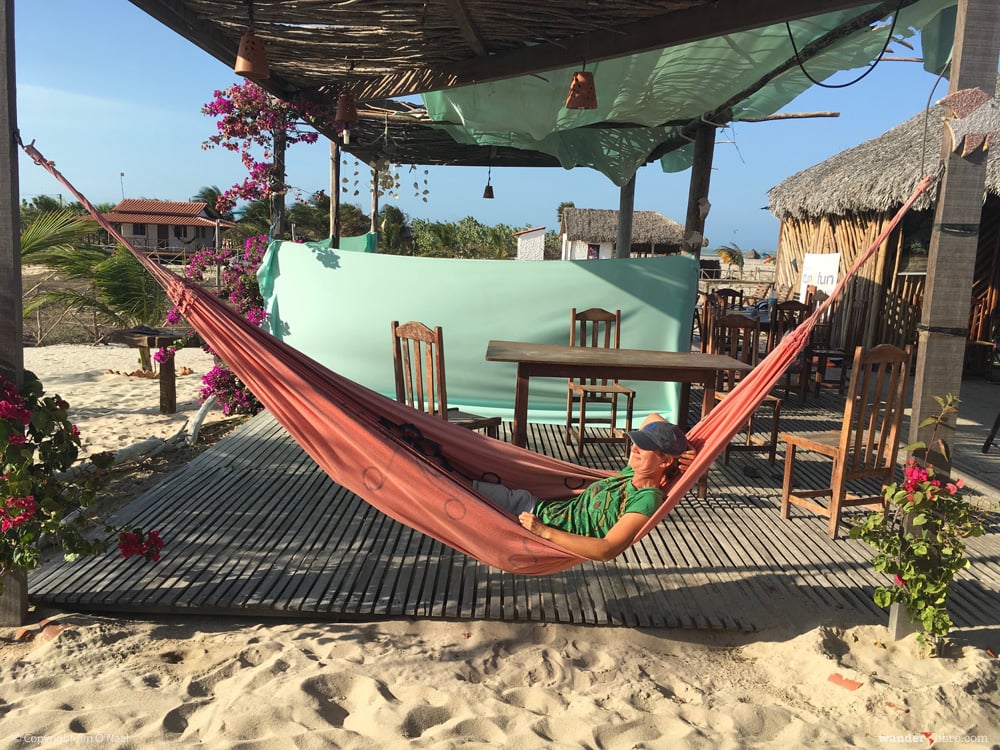
Planning Your Trip
Here are some useful tips and advice to get you started. Feel free to drop us a line if you’ve got questions or want to know more.
Disclosure: This page may contain affiliate links. Clicking through for additional information or to make a purchase may result in a small commission at no extra cost to you. We hope you find this information useful and welcome any questions you may have.
When to Go
Praia de Macapa’s kiteboarding season runs from July to January with peak season running October – December. Between July and January, the weather is sunny, dry, and warm and the winds are strong and reliable (typically picking up in the morning and building throughout the day).
Where to Go / How to Get There
Located 25 miles from Parnaiba in the Brazilian state of Piaui, Praia de Macapa sits on the Atlantic Ocean in northern Brazil. For most, the easiest way to get there is by flying into Fortaleza, 280 miles / 5.5 hours to the south, and either renting a car or organizing a transfer through Beekite or your guesthouse.
The 5th largest city in Brazil, Fortaleza has regular international and domestic flights, making it an ideal hub not only for reaching Praia de Macapa, but for onward travel in Brazil as well.
Where to Stay
Praia de Macapa is growing quickly and each year new lodging options become available. We stayed at Pousada Bougainville, a simple guesthouse with four basic rooms, one block from the ocean and a five-minute walk to Beekite. Pousada Bougainville’s big selling point is its convenient location and friendly owner (Pedro) who speaks several languages, including English.
Another excellent choice is Pousada Caju. More Upscale, Caju is a relaxing place to hang out with a small swimming pool, outdoor lounge area, bar, and restaurant. We discovered this little gem toward the end of out stay, so we didn't get to stay there. But we did get to know Vania, Caju’s friendly English speaking owner, and spent a good deal of time there lazing away afternoons (their acai bowl is some of the best we had in Brazil). We would highly recommend Caju if you’re looking for a nicer place. Click here to read their excellent reviews on booking.com.
It’s also possible to stay at Beekite, which has a couple of different options, including two private chalets located right on the beach. While it’s easy to walk anywhere in town, staying and taking lessons at Beekite is about as convenient as it gets.
Learning to Kitesurf in Brazil
As mentioned above, we took lessons with Beekite, which runs a full-service kiteboarding center right on the beach. In addition to a full range of courses for both beginner and advanced kiteboarders, Beekite also rents equipment and offers a weekly club membership that includes access to gear storage, showers/toilets, hangout area, and a private beach with an assistant to help land/launch your kit.
In addition, Beekite has a restaurant, and they run kiteboarding and wildlife viewing tours to the Parnaiba Delta.
Beyond Praia de Macapa
Praia de Macapa isn’t the only kiteboarding spot in Brazil. There are many places in Brazil to kitesurf. In fact, much of the coast between Fortaleza and Macapa Beach is blessed with ideal kiteboarding conditions. This presents boundless opportunities for the experienced kiteboarder to explore the northern Brazil coast.
Also, with regular flights from Fortaleza to cities throughout Brazil, it’s easy to add Rio, the Amazon (Manaus), the Pantanal or other destinations to your itinerary.
